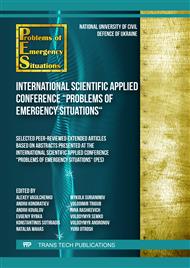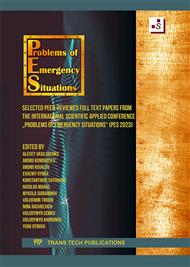[1]
EN 1990:2002/A1:2005/AC. Eurocode: Basis of Structural Design. The European Union Per Regulation 305/2011, Directive 98/34/EC, Directive 2004/18/EC, 2010.
Google Scholar
[2]
DBN V.2.1-10:2018. Bases and foundations of buildings and structures. Main principles, Kyiv: Ministry of Regional Development, Construction and Housing of Ukraine, 2018 [in Ukrainian].
Google Scholar
[3]
J.-L. Briaud, Geotechnical Engineering: Unsaturated and Saturated Soils, Wiley, 2013.
Google Scholar
[4]
Y.M. Cheng, C.W. Law, L. Liu, Analysis, Design and Construction of Foundations, London: CRC Press, 2021.
Google Scholar
[5]
J. Evans, D. Ruffing, D. Elton, Fundamentals of ground improvement Engineering, CRC Press, 2022.
Google Scholar
[6]
M.L. Zotsenko, Yu.L. Vynnykov, N.M. Pinchuk, S.M. Manzhalii, Research of "influence area" parameters of the foundations arranged without soil, TRANSBUD-2019, IOP Conference Series: Materials Science and Engineering, 708(1) (2019), 012076.
DOI: 10.1088/1757-899x/708/1/012076
Google Scholar
[7]
S. Gue, C.S. Gue, Geotechnical challenges on soft ground, Journal of Civil Engineering, Science and Technology, Malaysia, Sarawak, 13 (2022), 84-96.
DOI: 10.33736/jcest.4760.2022
Google Scholar
[8]
J.N. Gomez, D.M. Anderson, Soil cement stabilization – mix design, control and results during construction, Proc. of Intern. Symposium "Recent research, advances & execution aspects of ground improvement works" (Brussels, 2012), Vol. II, 2012, 319-325.
Google Scholar
[9]
R. Alipour, J. Khazaei, M. Pakbaz, A. Ghalandarzadeh, Settlement control by deep and mass soil mixing in clayey soil, ICE Proc., Geotechnical Engineering, 169 (2016), 319-330.
DOI: 10.1680/jgeen.16.00008
Google Scholar
[10]
Pham V., Turner B., Huang J., Kelly R, Long-term strength of soil-cement columns in coastal areas, Soils and Foundations, 57 (2017), 645-654.
DOI: 10.1016/j.sandf.2017.04.005
Google Scholar
[11]
K. Jendrysik, J. Rybak, Analysis of numerical model parameters for dry-mixed soil-cement composite with high content of organic matter, IOP Conference Series: Materials Science and Engineering, 869 (2020), 052007.
DOI: 10.1088/1757-899x/869/5/052007
Google Scholar
[12]
M.A. Sakr, M.A. Elsawwaf, A.K. Rabah, Performance of improved ground by deep mixing technique: state of the art review. Journal of Multidisciplinary Engineering Science Studies. 7 (2021). 3883-3892.
Google Scholar
[13]
Chu E.H. Theoretical prediction of jet grout column dimensions in stratified soil, Proc. of the 20th Intern. Conf. on Soil Mechanics and Geotechnical Engineering, Sydney: Australian Geomechanics Society, 2 (2022), 2875-2880.
Google Scholar
[14]
J. Hamada, K. Yamashita, T. Tanikawa, Large-scale load tests on bearing capacity of piled raft foundation with grid-form deep mixing walls, Proc. of the 20th Intern. Conf. on Soil Mechanics and Geotechnical Engineering. Sydney: Australian Geomechanics Society, 2 (2022), 3301-3306.
Google Scholar
[15]
A.H.M. Kamruzzaman, Long-term behavior of deep soil mixed columns for soft ground improvement lessons learnt from project, Proc. of the 20th Intern. Conf. on Soil Mechanics and Geotechnical Engineering, Sydney: Australian Geomechanics Society, 2 (2022), 3631-3636.
Google Scholar
[16]
D. Muir Wood, Geotechnical Modelling, First edition, London: CRC Press, 2004.
Google Scholar
[17]
K. Chau, Numerical Methods. Proc. of the 18th Intern. Conf. on Soil Mechanics and Geotechnical Engineering, Paris, 2013, 647–654.
Google Scholar
[18]
K. Faizi, A.S. A Rashid, D. Jahed Armaghani, R. Nazir, Deformation model of deep soil mixing using finite element method, Jurnal Teknologi (Sciences and Engineering), 74 (2015), 179-184.
DOI: 10.11113/jt.v74.3316
Google Scholar
[19]
L. Batali, H. Popa, D. Iancu, D. Knappe, G. Florea, Numerical modeling and calibration of a mixed pile-raft foundation for an 18-stories building with 3 basements, Proc. of the XVI ECSMGE Geotechnical Engineering for Infrastructure and Development, Edinburg, 2015, 3183-3187.
Google Scholar
[20]
L. Cocco, M.E. Ruiz, Numerical implementation of hardening soil model, Numerical Methods in Geotechnical Engineering IX, Vol 1, Proc. of the 9th European Conf. on Numerical Methods in Geotechnical Engineering (NUMGE 2018), Porto, Portugal, (2018)
DOI: 10.1201/9780429446931
Google Scholar
[21]
A. Bhutto, S. Zardari, S. Ghulam, Bhurgri, M. Zardari, R. Bhanbhro, B. Memon, B. Muhammad Munir, Mohr-Coulomb and hardening soil model comparison of the settlement of an embankment dam, Engineering, Technology & Applied Science Research, 9 (2019), 4654-4658.
DOI: 10.48084/etasr.3034
Google Scholar
[22]
M. Waheed, N. Asmael, Study simulation of shallow foundation behavior using different finite element models, Journal of Advanced Civil Engineering Practice and Research, 8 (2019), 4-9.
Google Scholar
[23]
M. Dhaybi, A. Grzyb, R. Trunfio, F. Pellet, Foundations reinforced by soil mixing: Physical and numerical approach, Proc. of Intern. Symposium "Recent research, advances & execution aspects of ground improvement works" (Brussels, 2012), Vol. III, 2012, 137-145.
Google Scholar
[24]
F. Celik, Modelling of pile load test in different soil models with finite element method and comparison with field test results, Omer Halisdemir University Journal of Engineering Sciences, 7 (2018), Is. 1, 182-192.
Google Scholar
[25]
Yu. Vynnykov, O. Voskobiinyk, M. Kharchenko, V. Marchenko, Probabilistic analysis of deformed mode of engineering constructions' soil-cement grounds, MATEC Web of Conferences, 116 (2017), 02038.
DOI: 10.1051/matecconf/201711602038
Google Scholar
[26]
O. Samorodov, D. Muliar, S. Tabachnikov, O. Krotov, Y. Vynnykov, M. Zotsenko, V. Shapoval, New design of a combined pile raft foundation for a multi-storey building with determination of its main parameters. Proc. of the 20th Intern. Conf. on Soil Mechanics and Geotechnical Engineering. Sydney: Australian Geomechanics Society, 2 (2022), 3493-3497.
Google Scholar
[27]
N.L. Zotsenko, Y.L. Vinnikov, Long-term settlement of buildings erected on driven cast-in-situ piles in loess soil. Soil Mechanics and Foundation Engineering, 53 (2016), Is. 3, 189-195, Springer Science + Business Media, New York.
DOI: 10.1007/s11204-016-9384-6
Google Scholar



